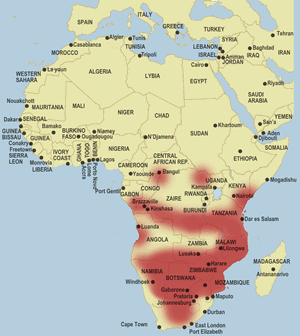Post by Ceratodromeus on Jun 15, 2015 1:21:41 GMT 5

Scientific classification
Kingdom: Animalia
Phylum: Chordata
Subphylum: Vertebrata
Class: Reptilia
Order: Squamata
Suborder: Serpentes
Family: Atractaspididae
Genus: Atractaspis
Species: A. bibronii
Description:
These snakes are relatively large, as far as burrowing asps go. Their standard body coloration is a jet black, with a white underside. the eyes are very small, the head square and flat. These are adaptations to the burrowing lifestyle these snakes are accustomed to. The bibron's burrowing asp spends most of its day in burrows dug by small mammals. They are a venomous species, with straight fangs. The method in which they attack prey has given them the nick name "stiletto snakes". Adult males average a total length of 47cm(18.5in) and a body mass of 31g, while females, significantly larger, average a total body length of 52cm(20in){1}, and a body mass of 37.5g. Large males measure as much as 63cm(24in) total body length, weighing 70g; Large females measure 61cm(24in) and weigh 71g.

(A) viperid, (B) burrowing asp, and (C) elapid palatal bones. Reference for image: {2}
Geographic range:
Bibron's burrowing asp can be found throughout Subsaharan Africa, ranging from Angola to Somalia.

Dietary habits:
A. bibronii spends the majority of its time in burrows dug by small mammals and tortoises. When they come across prey, because of the close-cornered habitat, they are known to stab live prey items with their fang while crawling
alongside the prey. They often do this until movement of the prey animal has ceased. Records of prey animals indicate that A. bibronii predates heavily on other burrow-dwelling snake species,lacertid lizards, skinks, amphibaenians, and nestling rodents.{1} When these snakes come across nests of newly born rodents, it isn't uncommon for them to eat all of the young in one sitting.{3}
Reproduction:
Not much is known on the mating habits of A. bibronii, Though clutch size for Burrowing asps ranges from 2-19 eggs and depends on the size of the maternal female.{1}
References:
{1}Shine, Richard, et al. "Biology of burrowing asps (Atractaspididae) from Southern Africa." (2009).
{2}Deufel, Alexandra, and David Cundall. "Feeding in Atractaspis (Serpentes: Atractaspididae): a study in conflicting functional constraints." Zoology 106.1 (2003): 43-61.
{3} Deufel, A. & Cundall, D. Functional plasticity of the venom delivery system in snakes with a focus on the post-strike prey release behavior. Zoologischer Anzeiger 245, 249-267.


